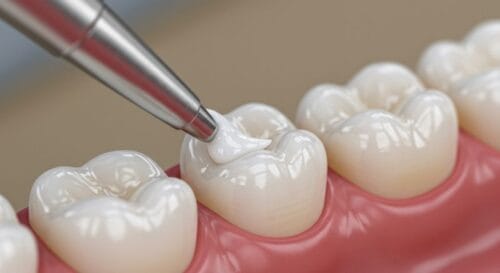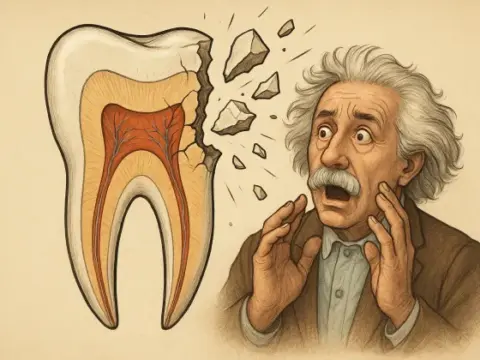Broken and decayed teeth are history, a perfect smile with filling!
Dental fillings provide excellent results both aesthetically and functionally by restoring your decayed, broken or cracked teeth. At AuraDent, we protect your teeth and restore their natural appearance. No matter how big the decay or damage is, you can regain healthy and strong teeth with a dental filling!


What is a tooth filling?
These are biocompatible materials used to replace the lost tissues of decayed, cracked or broken teeth. Dental fiflling is an effective treatment method for the protection of dental health. The purpose of the dental filling is to clean the decaying tissue before it reaches the canal, that is, the pulp tissue, and support tissue repair. In addition to restoring the function of the tooth, the filling also improves the aesthetic appearance. The tooth filling process is finished in a single session. Regular 6-month controls are available by our physicians.
How is a Tooth Filling Done?
Tooth filling is a dental procedure used to restore decayed, broken, or cracked teeth using specialized materials. The primary goal of a filling is to restore the tooth's function and appearance while preventing further decay or damage. By addressing the issue early, this procedure helps preserve the tooth and avoid the need for extraction.
"How is a tooth filling done?" Here are the key stages involved in the process:
- Local Anesthesia:
The area to be treated is numbed using local anesthesia. This ensures the patient remains comfortable and pain-free throughout the procedure.
- Cleaning the Tooth:
The dentist removes the decayed or damaged tissue using specialized tools. This step creates a clean and stable surface for the filling material to bond with healthy tooth tissue.
- Preparation of Filling Material:
The dentist selects and prepares the appropriate filling material (e.g., composite resin, amalgam, or ceramic) based on the tooth's location and the patient's needs.
- Placing the Filling:
The prepared filling material is carefully placed into the cleaned cavity. The dentist shapes and molds the material to ensure it matches the natural contours of the tooth.
- Hardening and Final Adjustments:
A special curing light is used to harden the filling material. Once hardened, the dentist polishes the filling to ensure a smooth finish and adjusts it for a comfortable bite. The procedure is typically completed in a single session.
Post-Filling Follow-Up
After completing the filling, the dentist checks for any issues, such as discomfort or an uneven bite. Patients are advised to avoid chewing on hard or sticky foods immediately after the procedure. Regular dental check-ups ensure the filling remains intact and functions optimally.
With proper care, a well-placed filling can last for years, restoring your smile and preserving your dental health.
Who Can Dental Filling Be Applied To?
Tooth filling is a treatment for decayed, broken or cracked teeth. If you have any dental problems, you can consult AuraDent's specialised dentists to find out which treatment method is most suitable for you.
In which cases dental fillings are applied:
- Tooth decay
- Teeth crack
- Teeth fracture
Types of Dental Fillings: Which Filling Should Be Preferred?
When choosing between dental filling types, you should consider various factors. Your dentist's recommendations, the condition of your teeth, your aesthetic preferences and your budget are effective in this choice. The choice of filling depends on the dentist's judgement. The dentist will select the most appropriate filling material according to the patient's individual needs and preferences.
What should be considered after dental filling?
If anaesthesia is used during the filling, the patient should not eat or drink until the anaesthesia wears off. Since the patient cannot feel the cheek and lip, he/she can bite the tongue and lip while chewing. The effect of anaesthesia can last 2-3 hours for the upper jaw and 4-5 hours for the lower jaw.
Does tooth sensitivity occur after tooth filling?
After the filling procedure, the tooth may be sensitive and painful for up to 12 hours depending on the procedure performed. In this case, the patient can use the painkiller recommended by the physician. In pain exceeding 12 hours and increasing in intensity, you should contact your physician.
How long does a tooth filling last?
It varies according to the position of the filling in the mouth, its size, the materials used, the number of fillings if more than one filling is to be made in the mouth, and the patient's compliance with the treatment.
What is aesthetic filling?
By using a material in a colour that is one-to-one compatible with the tooth tissue, it is aimed to make the treated tooth look both compatible with other teeth and aesthetic. As a result of this procedure, the goal is to ensure that the treated tooth is not visibly different from other teeth.
Can a Tooth Filling Fall Out?
Yes, a tooth filling can fall out due to several reasons, which often involve either external pressure or underlying dental issues. Some of the most common causes include:
- Secondary Caries (Recurrent Decay): If decay develops underneath or around a previously filled tooth, it can compromise the integrity of the filling, causing it to loosen or fall out.
- Teeth Grinding (Bruxism): Habitual clenching or grinding can place excessive pressure on the filling, leading to wear, fractures, or displacement over time.
- Abnormal Chewing Habits: Chewing on hard objects like ice, pens, or nails, as well as using teeth to open packaging, can weaken or dislodge fillings.
- Biting Hard Foods: Attempting to bite or crack open hard-shelled foods (like nuts) can cause stress on the filling, leading to fractures, cracks, or complete loss of the restoration.
How to Prevent Fillings from Falling Out
To protect your fillings and ensure their longevity:
- Maintain good oral hygiene to prevent decay around the filling.
- Avoid chewing on hard objects or foods.
- Wear a night guard if you grind your teeth.
- Visit your dentist regularly to monitor the condition of your fillings and address any signs of wear or damage early.
If your filling does fall out, schedule an appointment with your dentist as soon as possible to prevent further complications.
Does pregnancy cause tooth decay?
Pregnancy does not directly cause tooth decay, but it predisposes the oral cavity to tooth decay. The most important reason for this is the deterioration of oral hygiene as a result of night cravings or the increase in the acid level in the mouth as a result of vomiting.
Can nursing mothers have dental fillings?
There is no harm in breastfeeding mothers having dental fillings, but the mother should inform the physician about this situation before the treatment and breastfeeding should be planned after the treatment according to the anaesthesia used.



